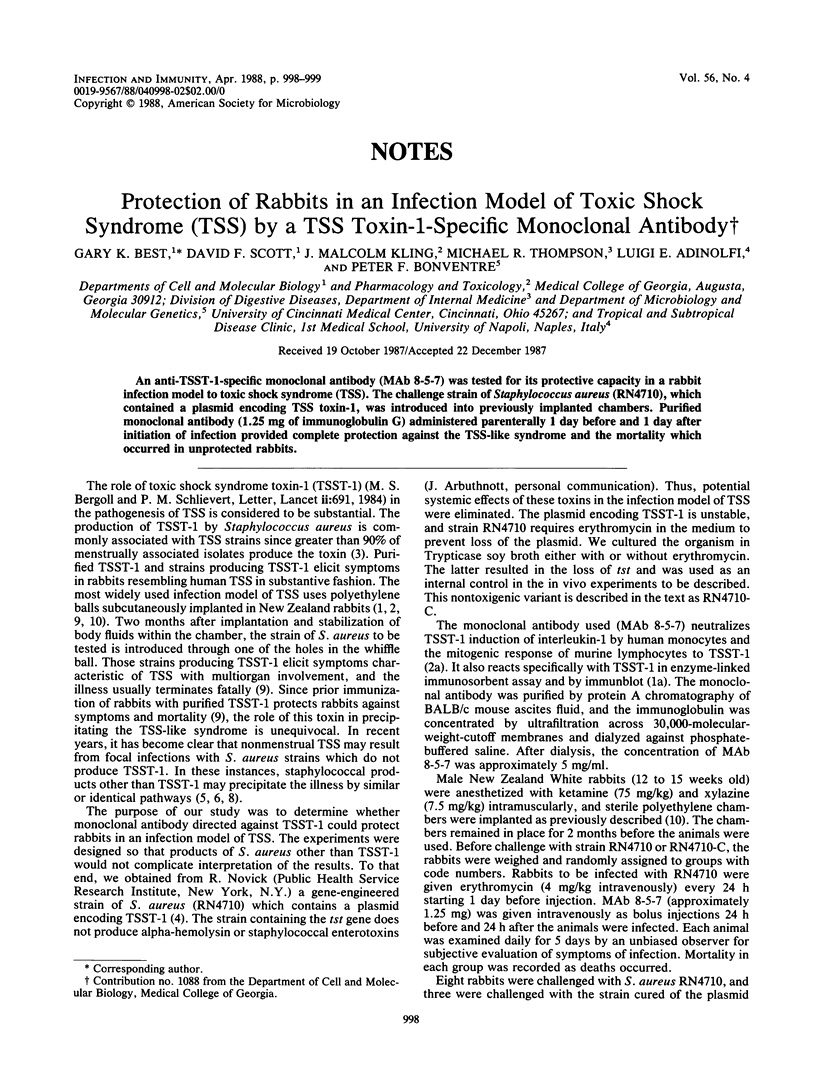Abstract
An anti-TSST-1-specific monoclonal antibody (MAb 8-5-7) was tested for its protective capacity in a rabbit infection model to toxic shock syndrome (TSS). The challenge strain of Staphylococcus aureus (RN4710), which contained a plasmid encoding TSS toxin-1, was introduced into previously implanted chambers. Purified monoclonal antibody (1.25 mg of immunoglobulin G) administered parenterally 1 day before and 1 day after initiation of infection provided complete protection against the TSS-like syndrome and the mortality which occurred in unprotected rabbits.
Full text
PDF

Selected References
These references are in PubMed. This may not be the complete list of references from this article.
- Arko R. J., Rasheed J. K., Broome C. V., Chandler F. W., Paris A. L. A rabbit model of toxic shock syndrome: clinicopathological features. J Infect. 1984 May;8(3):205–211. doi: 10.1016/s0163-4453(84)93859-3. [DOI] [PubMed] [Google Scholar]
- Beezhold D. H., Best G. K., Bonventre P. F., Thompson M. Synergistic induction of interleukin-1 by endotoxin and toxic shock syndrome toxin-1 using rat macrophages. Infect Immun. 1987 Dec;55(12):2865–2869. doi: 10.1128/iai.55.12.2865-2869.1987. [DOI] [PMC free article] [PubMed] [Google Scholar]
- Best G. K., Scott D. F., Kling J. M., Crowell W. F., Kirkland J. J. Enhanced susceptibility of male rabbits to infection with a toxic shock strain of Staphylococcus aureus. Infect Immun. 1984 Dec;46(3):727–732. doi: 10.1128/iai.46.3.727-732.1984. [DOI] [PMC free article] [PubMed] [Google Scholar]
- Bonventre P. F., Thompson M. R., Adinolfi L. E., Gillis Z. A., Parsonnet J. Neutralization of toxic shock syndrome toxin-1 by monoclonal antibodies in vitro and in vivo. Infect Immun. 1988 Jan;56(1):135–141. doi: 10.1128/iai.56.1.135-141.1988. [DOI] [PMC free article] [PubMed] [Google Scholar]
- Bonventre P. F., Weckbach L., Staneck J., Schlievert P. M., Thompson M. Production of staphylococcal enterotoxin F and pyrogenic exotoxin C by Staphylococcus aureus isolates from toxic shock syndrome-associated sources. Infect Immun. 1983 Jun;40(3):1023–1029. doi: 10.1128/iai.40.3.1023-1029.1983. [DOI] [PMC free article] [PubMed] [Google Scholar]
- Garbe P. L., Arko R. J., Reingold A. L., Graves L. M., Hayes P. S., Hightower A. W., Chandler F. W., Broome C. V. Staphylococcus aureus isolates from patients with nonmenstrual toxic shock syndrome. Evidence for additional toxins. JAMA. 1985 May 3;253(17):2538–2542. [PubMed] [Google Scholar]
- Milner L. S., de Jager J., Thomson P. D., Doehring R. O. Toxic shock syndrome caused by staphylococcal enterotoxin B. A report of 2 cases in children. S Afr Med J. 1983 May 21;63(21):822–824. [PubMed] [Google Scholar]
- Parsonnet J., Gillis Z. A., Richter A. G., Pier G. B. A rabbit model of toxic shock syndrome that uses a constant, subcutaneous infusion of toxic shock syndrome toxin 1. Infect Immun. 1987 May;55(5):1070–1076. doi: 10.1128/iai.55.5.1070-1076.1987. [DOI] [PMC free article] [PubMed] [Google Scholar]
- Schlievert P. M. Staphylococcal enterotoxin B and toxic-shock syndrome toxin-1 are significantly associated with non-menstrual TSS. Lancet. 1986 May 17;1(8490):1149–1150. doi: 10.1016/s0140-6736(86)91859-3. [DOI] [PubMed] [Google Scholar]
- Scott D. F., Kling J. M., Best G. K. Immunological protection of rabbits infected with Staphylococcus aureus isolates from patients with toxic shock syndrome. Infect Immun. 1986 Aug;53(2):441–444. doi: 10.1128/iai.53.2.441-444.1986. [DOI] [PMC free article] [PubMed] [Google Scholar]
- Scott D. F., Kling J. M., Kirkland J. J., Best G. K. Characterization of Staphylococcus aureus isolates from patients with toxic shock syndrome, using polyethylene infection chambers in rabbits. Infect Immun. 1983 Jan;39(1):383–387. doi: 10.1128/iai.39.1.383-387.1983. [DOI] [PMC free article] [PubMed] [Google Scholar]
- de Azavedo J. C., Foster T. J., Hartigan P. J., Arbuthnott J. P., O'Reilly M., Kreiswirth B. N., Novick R. P. Expression of the cloned toxic shock syndrome toxin 1 gene (tst) in vivo with a rabbit uterine model. Infect Immun. 1985 Oct;50(1):304–309. doi: 10.1128/iai.50.1.304-309.1985. [DOI] [PMC free article] [PubMed] [Google Scholar]


